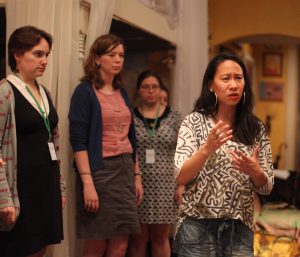
On October 19th, Mary Ng, the Canadian minister of small business and export promotion, announced another new initiative, the Women Entrepreneurship Fund, a two-year $20-million commitment to invest directly in women-owned and women-led businesses across all sectors of the economy to help them grow and reach export markets. The funding is another part of Canada’s first Women Entrepreneurship Strategy.
This new opportunity to procure direct investment is welcome news to many women entrepreneurs!
This funding announcement comes just four weeks after the announcement of $85M in funding to strengthen and improve access to women’s entrepreneurship programming. Surprisingly, this announcement received zero mainstream media attention, other than its mention in a recent opinion piece by LiisBeth publisher, PK Mutch. A Google search yields no results other than the Ministry’s own press release.
Jason Easton, Chief of Staff for Mary Ng, was not surprised about the lack of coverage, noting that in his experience, mainstream press often overlooks announcements related to women’s economic advancement. Easton added that the $85M fund would be spread over five years. Approximately $15M in total is earmarked for national organizations. The remaining $70M will prioritize regional, non-institutional applicants.
This is good news for community-based women-led co-working spaces, incubators, accelerators, networking organizations, and mentorship programs.
To learn more about how Minister Ng views the challenges faced by women entrepreneurs, read the Q&A prepared for LiisBeth by the communications staff at the Ministry of Innovation, Science and Economic Development Canada below. It’s a good time to be a woman entrepreneur.
QUESTIONS FOR MINISTER NG, & ANSWERS
Q1. What are some of the barriers that women entrepreneurs face?
Mary Ng: Women entrepreneurs face unique challenges compared to male entrepreneurs. They are less likely to seek financing and are more likely to be rejected or receive less money when they do. This has a huge impact on their ability to access capital.
As well, women entrepreneurs often have fewer mentorship and networking opportunities, face challenges in finding talent and expertise, and have difficulty securing large contracts and buyers. The impact of these barriers is clear: only 8.3% of women in Canada were self-employed in 2017 and only 16% of small businesses were women-led or -owned. We need to do better.
Q2. What are you doing to help women succeed in business?
Ng: The Government of Canada is committed to addressing the barriers women face in starting or growing a business. That is why the Government is seeking to ensure the full and equal participation of women in the economy by increasing their access to financing, talent, networks and expertise through the Women Entrepreneurship Strategy (WES) announced in Budget 2018.
The strategy has several key elements, including the Women Entrepreneurship Knowledge Hub, which aims to collect and gather data with the goal of providing information, data and best practices for women entrepreneurs. The WES Ecosystem Fund will provide funding for mentorship, networking and skills development through third-party initiatives. The Women Entrepreneurship Fund will directly invest in women-owned or -led businesses.
Q3. What is the Government of Canada doing to help women entrepreneurs overcome access-to-financing barriers?
Ng: The Women Entrepreneurship Strategy will make significant investments to improve women’s access to capital, advice, best practices and targeted, gap-closing support. The Government increased the lending resources for the Business Development Bank of Canada (BDC) to $1.4 billion. BDC’s Women in Technology Venture Fund was also increased to $200 million. As well, the Government provided Export Development Canada (EDC) with $250 million to help women-led businesses expand into international markets. The objective of all this is to support women-run businesses in starting up, scaling up and exporting.
Another program that will improve access-to-capital conditions for women entrepreneurs is the Venture Capital Catalyst Initiative. Through two investment streams, it aims to improve gender balance among Canadian VC managers and technology-based companies.
Q4. The Government has announced an investment of $105 million in women entrepreneurs. What are the goals of this investment?
Ng: The objective of this investment is to double the number of women-owned and women-led business by 2025 by increasing women’s access to capital, debt financing, networks and advice. This will be done through two initiatives.
One is the Women Entrepreneurship Fund. It will invest directly in women-led companies, enabling them to scale up and grow their businesses. The other is the Women Entrepreneurship Strategy (WES) Ecosystem Fund. It will invest in third-party, not-for-profit organizations so they can identify new and innovative ways to support women entrepreneurs by closing gaps in areas such as mentorship, networking and skills development.
Q5. What is the Women Entrepreneurship Fund?
Ng: The Women Entrepreneurship Fund is a two-year $20-million commitment to invest directly in women entrepreneurs in a diversity of industries, providing eligible companies with funding to help them grow. The fund will focus on supporting women entrepreneurs’ efforts to scale up and grow their businesses, as well as help them expand into new markets. .
Q6. What types of organizations are eligible to apply for funding under the Women Entrepreneurship Fund?
Ng: Women-owned or women-led for-profit small and medium-sized businesses (fewer than 500 employees), including individual business owners, partnerships, social enterprises, corporations, co-operatives and Indigenous businesses, are eligible to apply for funding under this initiative.
Q7. What will the Entrepreneurship Fund do for women entrepreneurs?
Ng: The Women Entrepreneurship Fund will provide successful applicants with up to $100,000 in funding (non-repayable contribution) to grow their existing businesses and help them mature to a state where they can pursue opportunities in new markets.
Activities that are eligible for funding include the development of market strategies and supply chain integration. The fund will also support women-owned and women-led firms in scale-up, expansion and growth activities such as product development, inventory management, upgrades to equipment and technology improvements.
Q8. Why is increasing the participation and success of women entrepreneurs important to Canada’s economic future?
Ng: We know that the full and equal participation of women in the economy represents untapped potential. According to McKinsey, we could increase Canada’s GDP by $150 billion by 2026 simply by advancing women in high-productivity sectors and raising their participation in the labour force.
It is essential to Canada’s competiveness that we support women entrepreneurs—not just because it’s the right thing to do but also because it’s good for the bottom line.
Q9. How is the Government addressing barriers faced by women entrepreneurs from diverse backgrounds?
Ng: Studies have shown that women from diverse backgrounds face additional barriers. The Women Entrepreneurship Knowledge Hub, a key pillar of the Women Entrepreneurship Strategy, aims to gather data on a variety of factors contributing to the current situation. Through the analysis of data, it will disseminate information, data and best practices for women entrepreneurs.
BDC is helping remove barriers for Indigenous women entrepreneurs. It is holding specific sessions of its WE Talk Business Boot Camps that are geared toward helping these women overcome barriers to entrepreneurship.
Q10. How else is the Government of Canada supporting women?
Ng: The Women Entrepreneurship Strategy complements the Government’s broader efforts to advance gender equality, which include addressing pay equity, introducing more affordable childcare and putting an end to gender-based violence.
The Government is introducing a Gender Results Framework to guide future decision making and to measure its progress in fostering an economy that works for everyone. As well, it is moving forward with legislation to address pay equity in federally regulated sectors and is encouraging pay transparency by publishing its pay practices online.
In addition, the Government is helping women enter the trades with Apprenticeship Incentive Grants, implementing a National Housing Strategy that commits at least 25% of investments to projects that support women’s housing needs, and enhancing the Canada Child Benefit to help with the cost of raising children.












 New York City (Catherine Drillis)
New York City (Catherine Drillis)





